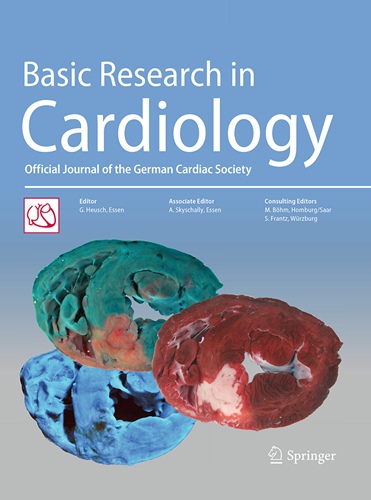Sex differences in a murine model of infective endocarditis.
IF 8
1区 医学
Q1 CARDIAC & CARDIOVASCULAR SYSTEMS
引用次数: 0
Abstract
Infective endocarditis (IE) is a highly lethal disease with a notable male predominance, yet the biological basis for this sex disparity remains unclear. We established a murine IE model in C57BL6 mice in which aortic valve injury was induced via wire-injury and followed by intravenous injection of Staphylococcus aureus. Infection was confirmed by blood and valve cultures, and cardiac function was evaluated by echocardiography. Systemic cytokine levels were measured, and immune cell infiltration in valve tissue was assessed by flow cytometry and immunofluorescence. In the murine model, IE was induced in 77/85 animals. Male mice exhibited significantly higher bacterial loads in blood and valves, greater valve cusp enlargement, increased ventricular volumes, and more frequent aortic regurgitation. Both sexes showed strong neutrophilic responses, but males had markedly elevated systemic IL-1α, IL-1β, IL-6, and TNF-α levels. Females demonstrated earlier and more robust recruitment of CD68⁺ and CD206⁺ macrophages, as well as Ly6G⁺ neutrophils, to the injured valve, correlating with reduced bacterial vegetations. This murine model mirrors the clinical sex disparity in IE: males develop more severe disease and systemic inflammation, while females benefit from a rapid, localized immune response. These findings provide a platform for dissecting molecular drivers of sex-specific susceptibility in IE.感染性心内膜炎小鼠模型的性别差异。
感染性心内膜炎(IE)是一种高度致死性疾病,男性明显占优势,但这种性别差异的生物学基础尚不清楚。我们建立了C57BL6小鼠的IE模型,通过钢丝损伤诱导主动脉瓣损伤,然后静脉注射金黄色葡萄球菌。通过血液和瓣膜培养确认感染,并通过超声心动图评估心功能。采用流式细胞术和免疫荧光法检测瓣膜组织中免疫细胞的浸润情况。在小鼠模型中,77/85只动物诱导IE。雄性小鼠在血液和瓣膜中表现出明显更高的细菌负荷,更大的瓣尖增大,心室容积增加,更频繁的主动脉反流。两性均表现出强烈的嗜中性粒细胞反应,但男性的全身IL-1α、IL-1β、IL-6和TNF-α水平明显升高。雌性小鼠表现出CD68 +和CD206 +巨噬细胞以及Ly6G +中性粒细胞更早、更强地向受损瓣膜募集,这与细菌植被减少有关。这个小鼠模型反映了IE的临床性别差异:雄性会患上更严重的疾病和全身性炎症,而雌性则受益于快速的局部免疫反应。这些发现为剖析IE中性别特异性易感性的分子驱动因素提供了一个平台。
本文章由计算机程序翻译,如有差异,请以英文原文为准。
求助全文
约1分钟内获得全文
求助全文
来源期刊

Basic Research in Cardiology
医学-心血管系统
CiteScore
16.30
自引率
5.30%
发文量
54
审稿时长
6-12 weeks
期刊介绍:
Basic Research in Cardiology is an international journal for cardiovascular research. It provides a forum for original and review articles related to experimental cardiology that meet its stringent scientific standards.
Basic Research in Cardiology regularly receives articles from the fields of
- Molecular and Cellular Biology
- Biochemistry
- Biophysics
- Pharmacology
- Physiology and Pathology
- Clinical Cardiology
 求助内容:
求助内容: 应助结果提醒方式:
应助结果提醒方式:


